Kererū (kukupa) are big, beautiful and often unintentionally comic birds that are easily recognised, even when flying. They’re one of the biggest pigeons in the world and can live for 20-30 years. But kereru only raise one chick at a time and don’t necessarily nest every year. That can make them vulnerable.
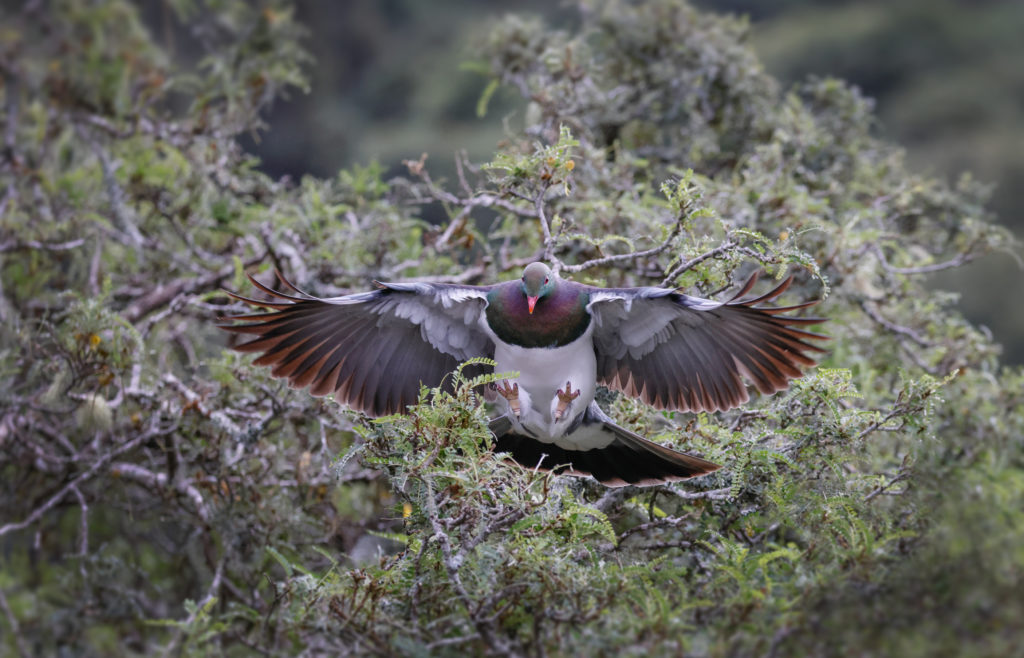
Kererū used to be abundant across New Zealand until forest clearances and introduced predators caused a rapid decline. But how are they doing these days? Some sources report an apparent increase in numbers, but is that really the case?
Researchers Joanna K. Carpenter, Susan Walker, Adrian Monks, John Innes, Rachelle Binny and Ann-Kathrin Schlesselmann from Manaaki Whenua – Landcare Research and Te Pūnaha Matatini, Centre of Research Excellence, have been investigating what factors are limiting kereru across New Zealand. In a recently published article, they report on whether or not sanctuaries are making a difference and whether kereru numbers might be starting to climb again, at least in some locations.
“Results from the New Zealand Garden Bird Survey and the Great Kererū Count suggest that kererū detections increased significantly over recent years, but these data are spatially biased towards urban environments. Therefore, little is known about recent trends in kererū distribution and abundance on a national scale,” the researchers write.
Kererū have an impressive ability to gulp down big food items. They eat the foliage and fruit of many plant species, and they are important dispersers of New Zealand’s six largest seeded plant species – because they’re the only surviving bird species that can swallow the large fruit.
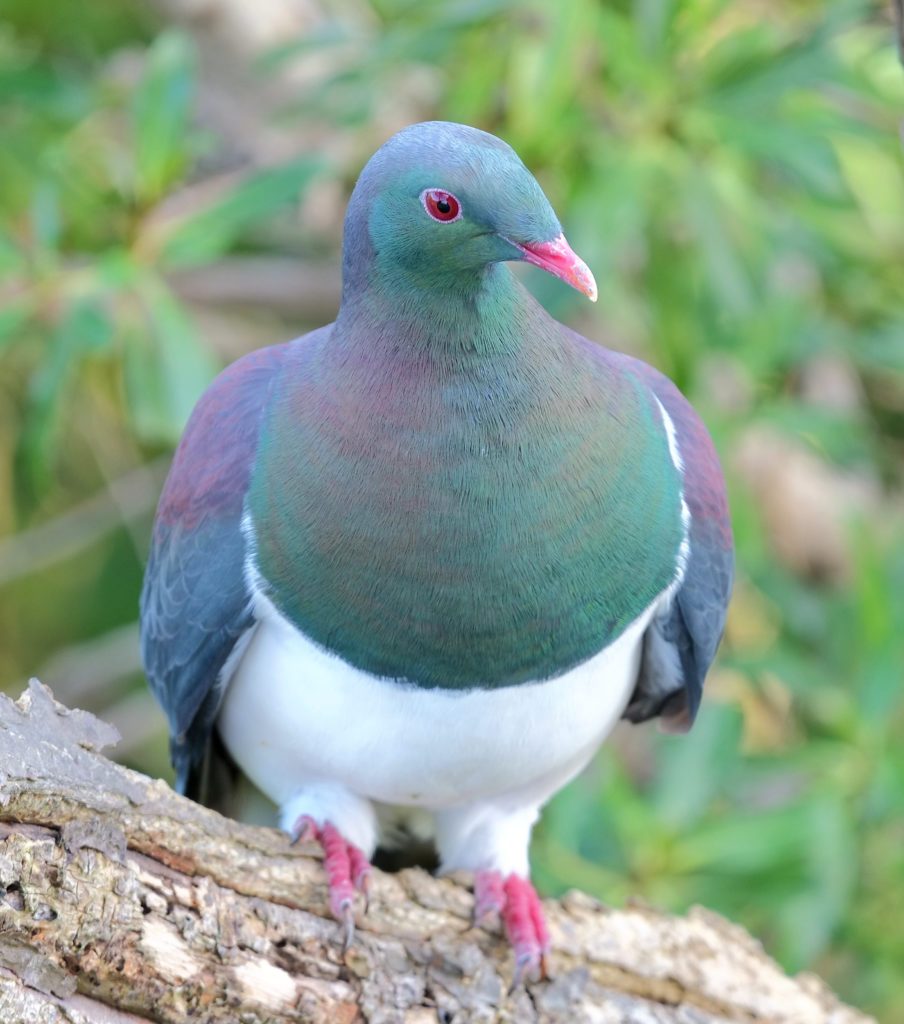
Reduced forests mean less available food and habitat – and introduced predators like rats and possums have a double-whammy effect: they can prey on eggs and chicks and compete with kereru for fruit, seeds, leaves and berries. So are predators the biggest problem or lack of forests?
“Ecologists have long debated the relative importance of topdown (e.g. predators) versus bottom-up (e.g. food) processes in regulating avian populations. Often, however, the relative importance of these processes is conditional: for example, the introduction of a novel predator may result in top-down processes primarily regulating a population, whereas in other situations habitat degradation may lead to bottom-up processes dominating. Teasing apart which processes dominate across different situations is important for conserving and recovering endangered species.”
Kererū hatch and raise one chick at a time, incubating their single egg in a twiggy nest for about 4 weeks. The parents feed the chick a protein-rich “milk”, which they secrete from their crops, adding partially-digested fruit to their diet after a couple of weeks. The chick leaves the nest at 30-45 days old, but the parents continue feeding them. So in total the single egg/chick is in the nest for 60-75 days. That’s a lot of opportunity for nest-raiding predators.
“Kererū can suffer high levels of nest predation by introduced mammals such as ship rats, brushtail possums and stoats,” say the researchers. “Kererū may also be particularly susceptible to the effects of food limitation because their breeding efforts are highly variable and appear to be correlated with food supply.”
Lack of food can increase mortality of adults and fledglings through starvation, but it can also have an indirect effect by increasing predation risk (hungry adults are at the nest less) and increasing susceptibility to parasites or disease.
“Introduced mammals interact with food supply because several introduced mammals are omnivores (e.g. possums and rats), which both kill kererū and consume kererū foods. Thus, disentangling the primary drivers of decline can be difficult.”
The research project aimed to test whether predation and food resources are the two key factors that combine to shape kererū populations in the forests, production landscapes, and urban areas of New Zealand.
“We assess three sources of information. First, we review the literature on factors affecting the vital rates (nesting success and adult mortality) of kererū to give insights into possible agents of decline or limitation. Second, we examine a major database of bird abundance within sanctuaries across New Zealand to evaluate long-term responses of kererū to intensive pest control at local scales and calculate pest density-impact functions. Third, to understand the factors underlying temporal and spatial kererū distribution patterns at a national scale, we assess changes and patterns in kererū local occupancy through time using data from the 1969–1979 and 1999–2004 editions of the Atlas of Bird Distribution in New Zealand.”
“Specifically, we ask (1) whether there have been declines in kererū occupancy between the 1970s and 2000s across New Zealand, and (2) how patterns of kererū occupancy relate to indigenous forest cover, temperature, urbanisation, and forest type (podocarp or beech dominated).”
The researchers had three hypotheses about the mechanisms driving differences and changes in local occupancy:
- Kereru occupancy would be highest in forested squares. “Although kererū occur in non-forested environments, we expected that they were nevertheless likely to have mainly inhabited forest and forest edges in pre-settlement New Zealand, and that forest loss would compromise occupancy.”
- Temperature would have an indirect effect on kererū occupancy by acting as a proxy for predation rates and food supply. “Mean annual temperature and forest type are two key predictors of both mammalian pest densities and food availability. Densities of ship rats and possums are low much of the time in cooler, floristically simpler forests dominated by beech (Nothofagaceae species), although ship rats do irrupt to very high densities intermittently following synchronised heavy seeding (masting)… If predation is still causing declines in kererū populations and there is abundant indigenous forest, kererū occupancy should be lowest and more stable in cold sites, where food is either the primary limitation or limits population recovery following periodic outbreaks of predators. Conversely, in warmer, forested sites, where food is less limiting and median pest densities are highest, kererū should be decreasing most rapidly over time.”
- Kererū occupancy would be stable or increasing in urban areas due to nutritional supplementation and/or lower abundance of ship rats, possums, and stoats. “Urban areas contain a different suite of pests to forest areas and the resources provided by floristically diverse urban parks and gardens might promote kererū fecundity, outweighing the potential negative effects of urbanisation (e.g. an increased risk of collisions with windows and vehicles) on kererū survival.”
The researchers collated reports of 397 kererū nests from 20 studies and 10 sites with differing levels of mammalian pest control across mainland New Zealand.
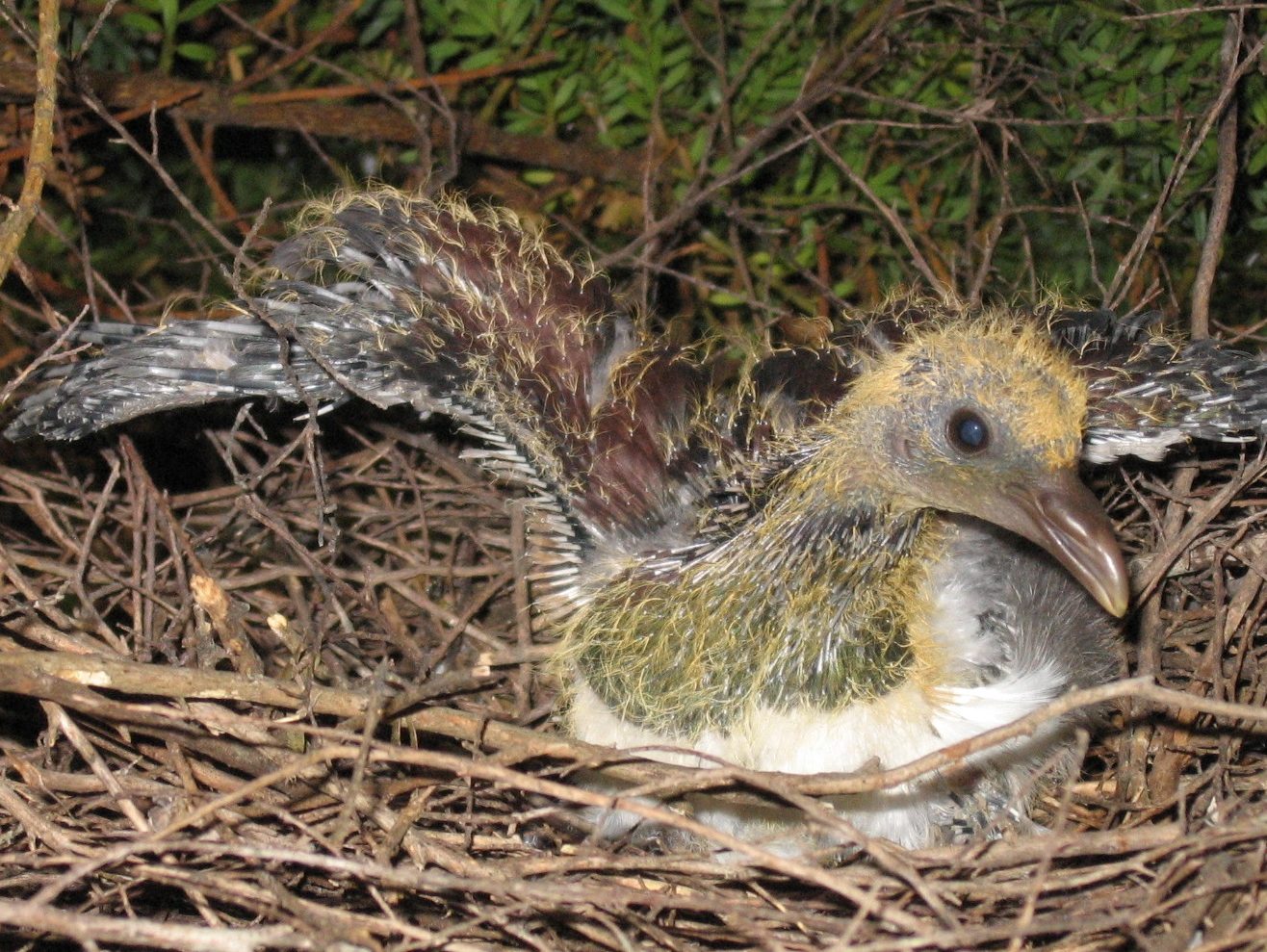
“The causes of nest failure were reported for 194 nests. With or without pest mammal control, nest failure causes, in declining order of importance, were predation of eggs and chicks, then desertion. The identity of the predator was determined for almost half (53 of 113) of all depredated nests at managed and unmanaged sites. Most eggs were eaten by either ship rats (50.0%, n = 42) or possums (38.1%, n = 42), while most chicks were killed by stoats (72.7%, n = 11).”
The proportion of kererū nests that successfully fledged a chick differed depending on what kind of pest management regime was used.
“Nest success increased significantly compared to no management if pest mammal control was targeting rats or rats and possums simultaneously. The proportion of successful nests was not significantly influenced by control of possums alone.”
Kererū could be expected to live on average 20–30 years in an ideal, intact ecosystem.
“The mean life expectancy estimated from five sites where kererū were radio tracked was much shorter, ranging from 1.55 years at Whirinaki to 5.4 years at Pelorus Bridge and Taranaki. Most recorded deaths were attributed to predation, although for most cases the predator could not be identified. Stoats and cats were the only mammalian predators that were identified killing adult kererū. In urban areas, mortalities caused by impact injuries were common. Small numbers of kererū deaths were attributed to other causes such as disease, starvation, and electrocution.”
Data from 11 sanctuaries was used to examine the response of kererū to long-term pest control and here the results were sometimes surprising.
“Two sanctuaries were ring-fenced with complete eradication of rats, stoats, and possums, two sanctuaries were peninsula-fenced with complete eradication of rats, stoats, and possums and the remaining seven sanctuaries were unfenced mainland islands that attempted to continually suppress rats, possums, and stoats to very low levels. Kererū detections did not always markedly increase in response to pest control or eradication.”
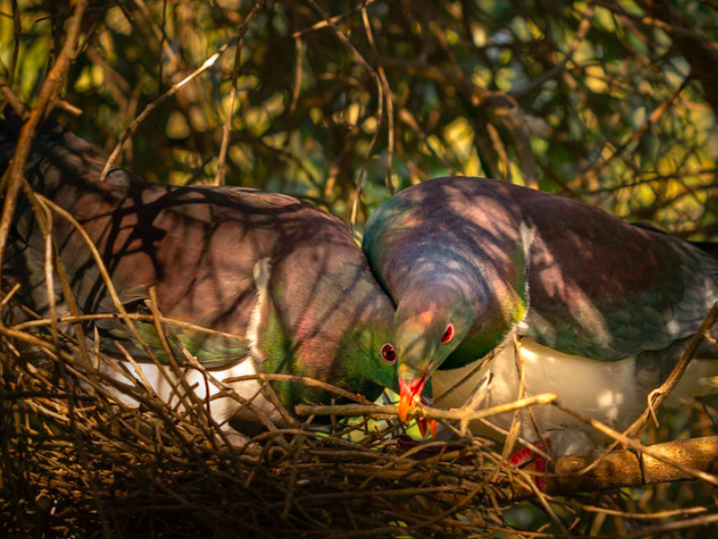
“Only one site appeared to show a steady increase of kererū over time since management began (Tāwharanui), with most sites showing an initial increase in kererū in response to pest management that either plateaued or declined over time. Most of the sites that had eradicated rats, possums, and stoats did not have obviously better outcomes for kererū than the unfenced mainland islands.”
When it came to kererū occupancy across New Zealand, the North Island seems to be doing better than the South.
“In the North Island the average probability of kererū local occupancy within a square increased slightly (but not significantly) from 0.37 during the first survey (1969–1979) to 0.40 in the second survey (1999–2004). By contrast, mean probability of occupancy in the South Island fell significantly from 0.36 to 0.27.”
So what does it all mean for kereru? The authors explain.
“Our literature review of factors affecting vital rates in kererū support the argument that predation by introduced mammals (i.e., top-down processes) is the primary factor limiting kererū in areas with sufficient habitat (e.g. intact forests). Vital rates such as nesting success and adult survival are important population parameters, and our literature review demonstrates that predation by pest mammals severely reduces both.”
“The cause of most kererū nest failures when mammalian pests are not controlled is predation of the egg by possums and rats, and predation of chicks by stoats. Our results show that controlling possums and rats together boosts kererū nesting success significantly. However, for a K-selected species [fewer offspring, long-lived] like kererū, the loss of adult females may have far more effect on population trends than the loss of eggs and young. The cause of most adult deaths is predation by stoats and cats, although the predator identity cannot always be determined.”
Food limitation appears to be less of an issue than predators.
“If food limitation was the primary limiting factor for kererū, we would expect this to be evident in vital rates, which record starvation of chicks or adults, and egg desertion. Yet although some adult kererū mortalities have been attributed to starvation, our collated data show this causes an insignificant number of deaths in comparison to predation, while starvation of chicks and desertion of nests was infrequently observed.”
The food factor may be kicking in when it comes to predator-controlled sanctuaries however.
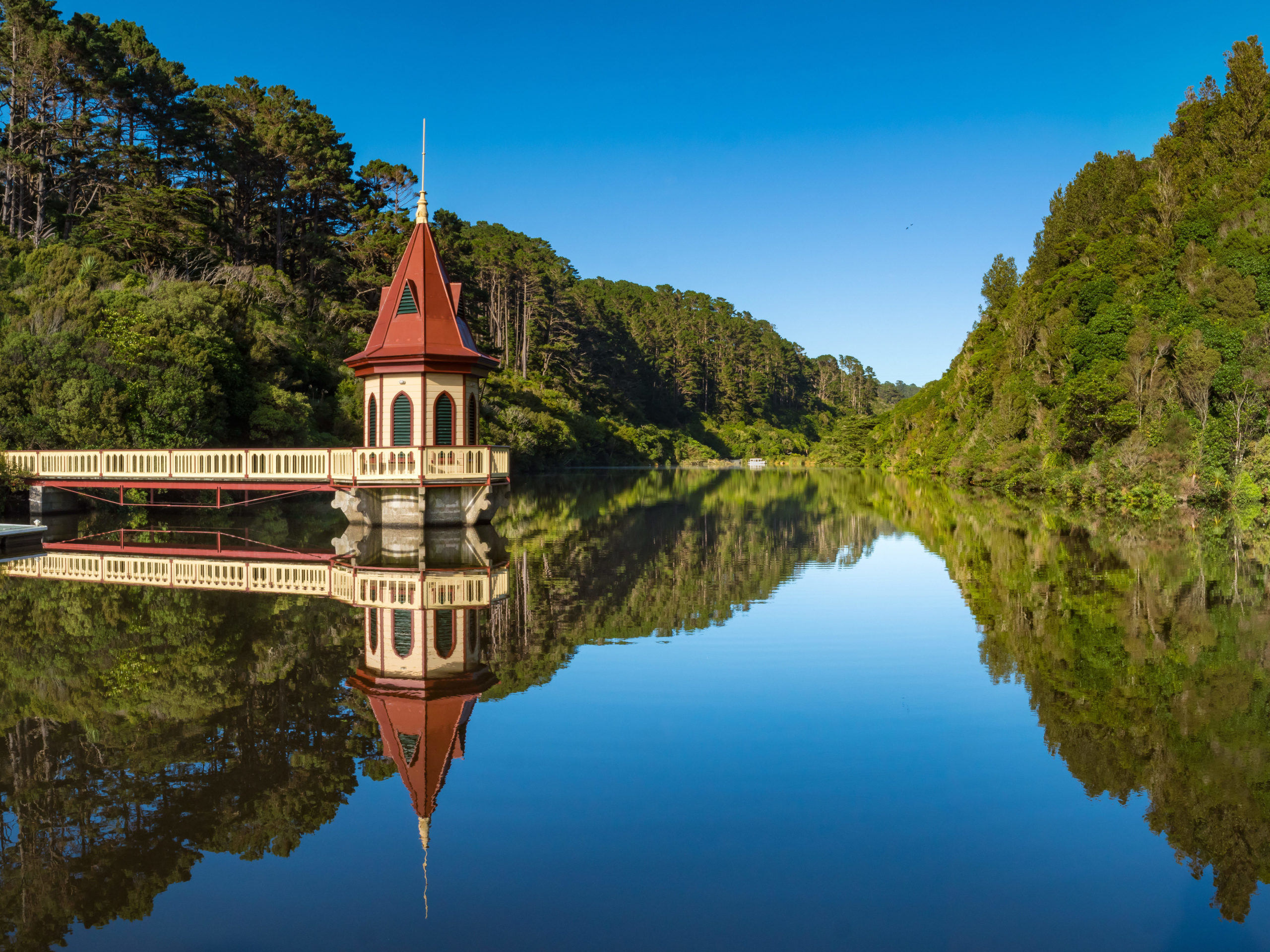
“The long-term kererū count data from 11 sanctuaries suggest that bottom-up (e.g. food limitation) processes have a part to play in regulating kererū populations outside of intact forest. While intensive management of rats, possums, and stoats often resulted in increased kererū detections, a relationship also demonstrated on pest-free offshore islands such as Motutapu and Tiritiri Mātangi, this relationship was not always consistent.”
“First, many of the sanctuaries only encompass a small area of protected habitat, and that habitat is not always rich in food for kererū. At these sites, factors other than predation – probably food or habitat scarcity – may be secondarily limiting, or co-limiting, kererū. For example, Rotoiti Mainland Island is comprised entirely of beech forest, which is not high-quality habitat for kererū. Supplementary feeding experiments at these sites would test this hypothesis.”
“Second, the low reproductive rate of kererū means that there may be a considerable lag before increased numbers of kererū are observed in sanctuaries. Finally, kererū are highly mobile, with home ranges as large as 31 732 ha and excellent ability to cross habitat gaps. These factors make the interpretation of responses to management difficult: the kererū detected at non-treatment sites may be the same individuals detected in sanctuaries. Alternatively, increased numbers of kererū at a managed site may simply reflect immigration into the site rather than a net increase of kererū in the wider landscape.”
The poor occupancy results for southern kereru compared to their northern relatives is another surprise in the results.
“Nationwide occupancy patterns offer mixed support for the role of predation as the primary limiting factor of kererū populations. Under this hypothesis we expected kererū to have declined most in the warmest, most productive forests, where year-round median densities of ship rats and possums are highest. This is the trend seen for several of New Zealand’s forest birds, which are being increasingly confined to thermal refuges in cool, higher-elevation forests. Instead, we saw different patterns in the North and South Islands. Kererū occupancy across the North Island remained stable between the two time periods, despite higher predicted median rat and possum densities in these forests. In contrast, kererū occupancy declined almost everywhere across the South Island, including for isotherms equivalent to those in the North Island, and most dramatically in warmer podocarp-dominated forests.”
The authors suggest several possible explanations. Higher reproductive rates in the North Island could be offsetting the effects of predation. Kererū in Northland, for example, may lay eggs at any time of year except when moulting. Predation risk may be higher for the same isotherm in the South Island than in the North Island.
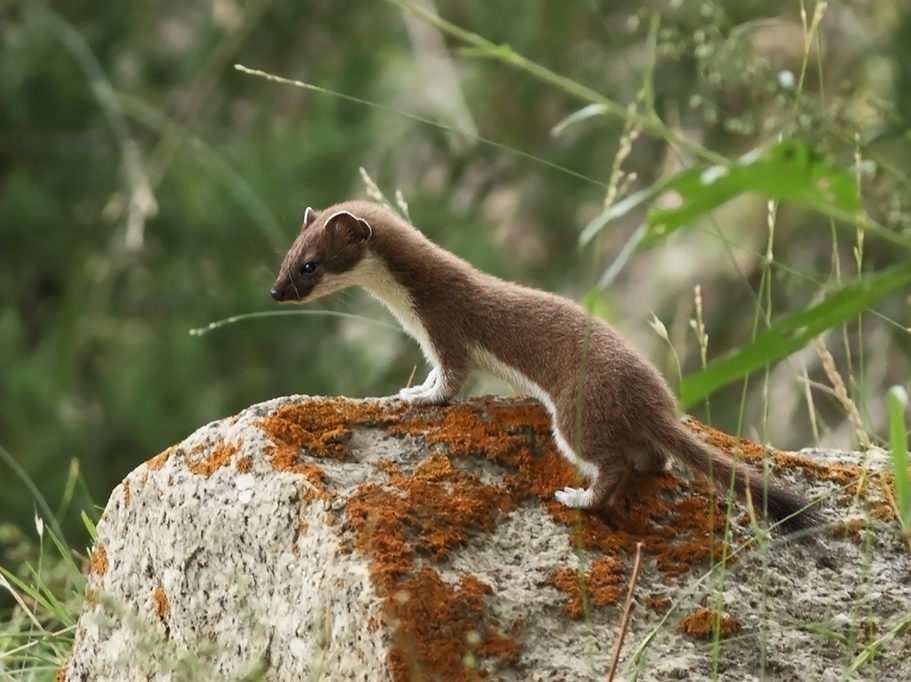
“While rats and possums probably have higher median densities in the North Island compared to the South Island, rats are more irruptive in the South Island. These irruptive rodent dynamics (which often result in irruptions in stoats too) may have a bigger impact on kererū than higher median, but less variable, rodent densities. We found that stoats were a major cause of death for adult kererū, so if stoat densities are higher or more irruptive in the South Island, this could have driven the observed declines in kererū occupancy.”
In deforested regions of New Zealand (e.g. Hawke’s Bay, Manawatu, and Canterbury), forest scarcity probably trumps mammalian pests as the primary limiting factor for kererū. Occupancy was much higher in forest compared to non-forest and podocarp-dominated forests (with their higher plant species richness) had higher kereru occupancy than beech forests.
But what about our cities, where kererū are anecdotally thought to be increasing.
“Kererū are capable of living in highly modified habitats such as farmland shelterbelts, urban parks, and rural and suburban gardens, but these habitats only support low numbers. Kererū are probably able to live in these modified habitats due to their high mobility, which allows them to move from fragment to fragment in search of food.”
“Kererū occupancy in urban areas remained low, yet stable, over the two time periods, which suggests that the factors that drove kererū declines across forested and rural areas of the South Island are less influential in urban landscapes. Results from the Garden Bird Survey support this argument, as kererū detections have undergone a shallow increase since the survey began in 2007. Urban landscapes typically have lower numbers of mustelids and ship rats than forests, and the diversity of exotic and native plantings may provide a more constant stream of food for kererū through the year.”
So should be more worried about kereru – especially in the South?
“Our analyses revealed that while mean kererū occupancy remained stable across the North Island between 1967–1979 and 1999–2004, it significantly declined in the South Island. As occupancy often covaries with abundance, this result suggests that kererū abundances also declined in the South Island over this period. This prediction is consistent with the one study we know of that measured kererū relative abundance over a similar time period in the South Island, which found that kererū detections declined significantly between the 1980s and 2000s. However, it differs from expert opinion that kererū populations have been increasing since that time, reflected in the current threat status of kererū as “not threatened” as opposed to the earlier classification of “chronically threatened (gradual decline).”
So it might be time to rethink that classification.
“The recovery of kererū requires maximising nesting attempts and their fledging success, and then limiting mortality of the subsequent subadults and adults. Our results suggest that intervention is particularly needed in warm, South Island forests, where Atlas data show that kererū experienced the steepest occupancy declines in recent decades. In aggregate, these steps demand both maximising year-round food supply and minimising predation at all life stages. Largescale control of the ubiquitous, omnivorous, and arboreal ship rats and brushtail possums will achieve both aims and has been shown to result in increased kererū detections, but additional actions are also needed. Stoats and feral cats are key predators of adult kererū, while deer, goats, and other browsers limit regeneration of desirable kererū food plants, which may affect kererū. In heavily deforested regions, a long-term programme of planting food-providing trees would also be needed to restore sufficient area and connectivity of suitable habitat.”
It will be interesting to see what the latest Bird Atlas data reveals when the survey is completed in 2023.
“The last atlas data are now 16 years old and we do not yet know the net outcome for kererū of increased predator management since the 1999–2004 data were collected. These data will show how kererū distribution is changing across the country, and whether the declines in the South Island are ongoing.”
The full research report is published in the New Zealand Journal of Ecology and is freely available online.
Factors limiting kererū (Hemiphaga novaeseelandiae) populations across New Zealand (2021)

